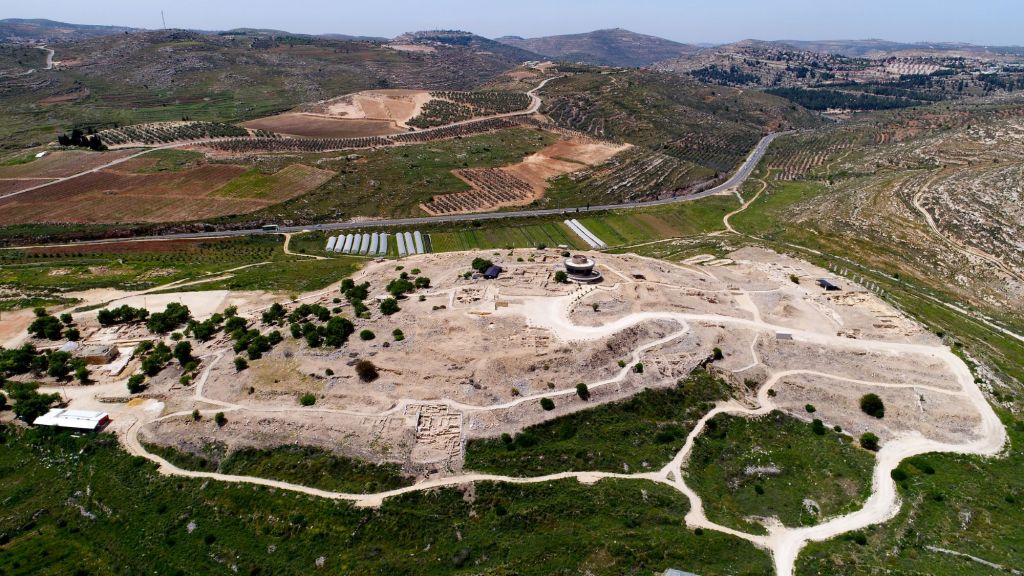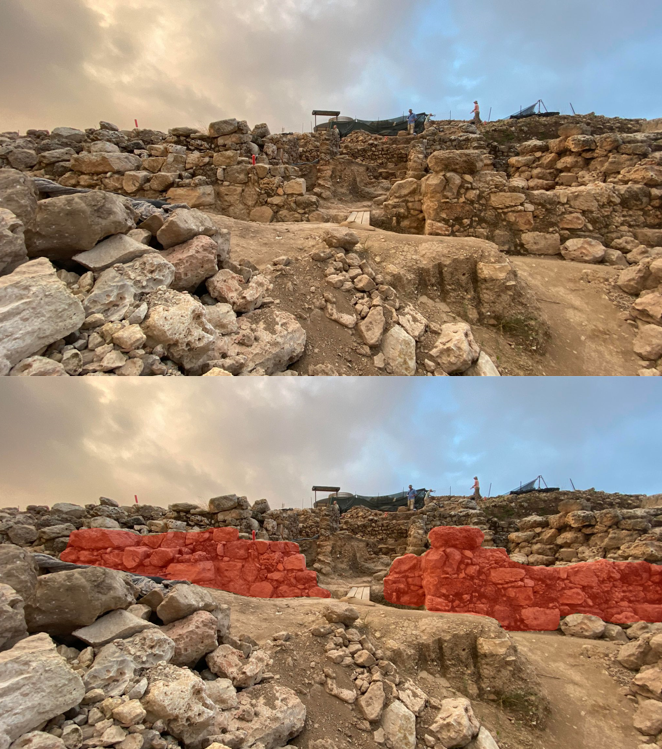
The Bible is rooted in real history. This is why archaeology is such a valuable tool; it helps us uncover the biblical world and provides us with important background knowledge about the people, places, and events described in the text.
From May 20 – June 4, 2023 I was part of the Associates for Biblical Research’s (ABR) archaeological team at Shiloh, Israel. During my first week there, we were excavating in the northeast square of a monumental building that may be the location of the tabernacle (see below). In week two, I excavated in Area D, a Late Bronze Age favissa (cultic burial pit), which contained the remains of mostly kosher animal bones that had been sacrificed and pottery that appears to date to the time of Joshua. We also unearthed an Egyptian scarab and a gold pendant in Area D. The gold pendant might have come from an Egyptian broad necklace, which may have been part of the plunder the Israelites brought with them from Egypt (Ex. 3:22). You can hear more about my experience excavating at Shiloh in this Digging for Truth podcast.
Shiloh was settled by the Amorites in the Middle Bronze Age IIb period (ca. 1750-1650 BC) as an unwalled village. Sometime during the Middle Bronze IIc/III period the people of Shiloh built a massive stone wall (up to 5m thick) around their village, enclosing an area of 4.25 acres.1 From a biblical perspective, Shiloh is best-known for being the place where the Tabernacle stood for over 300 years. It is where Joshua first set up the tabernacle (Josh. 18:1) and from where he allotted the territories to the tribes of Israel (Josh. 18:10). It was at Shiloh that Eli, the priest ministered, and it is where Samuel, the prophet grew up (1 Sam. 1:1–28). Three times per year, the Israelites gathered at Shiloh for the great feasts. It was, in essence, the first capital city of ancient Israel.
As I walked where Joshua, Eli, and Samuel had walked at Shiloh, I was struck by the fact that I was witnessing and unearthing things that they had seen. This reminded me of an older blog series I wrote called, “Footsteps,” in which I used archaeology to walk in the footsteps of biblical people. I’ve always found this a helpful way to contextualize and understand the biblical text. Here are the previous blogs in this series:
- Three Things in Egypt Joseph Likely Saw
- Three Things in Capernaum Peter Likely Saw
- Three Things in Jerusalem Jesus Likely Saw
- Three Things in Canaan Joshua Likely Saw
- Three Things in Corinth Paul Likely Saw
- Three Things in Babylon Daniel Likely Saw
- Three Things in Ephesus Timothy Likely Saw
- Three Things in Susa Esther Likely Saw
In this blog, I’d like to share three things in ancient Shiloh that Samuel likely saw.

The Northern Gate

Before the Israelites arrived, the Amorites dwelt at Shiloh and fortified the city in the Middle Bronze Age. The location of the ancient city’s gate was a mystery until 2018, when the ABR team discovered a breach in the northern wall. Earlier ABR excavations had discovered that the glacis (defensive embankment) against that wall ended at a certain point. This gap corresponded with a gap in the northern perimeter wall which had an intentionally terraced slope up to it. The further discoveries of a socket stone seems to affirm the identification of this location as a gate. This year (2023) a row of columns made of stacked stones was unearthed outside of the wall in what appears to be a gate complex.2 While it was constructed in the Middle Bronze Age, it likely continued to be used throughout the Late Bronze Age and Early Iron Age.3
A gate in the northern wall makes sense, as the main spring for ancient Shiloh was located a kilometer north of the city. This may have been the gate where Eli died upon hearing the news that the Ark of the Covenant had been captured in battle (1 Sam. 4:18). Samuel no doubt went in-and-out of this gate many times while he lived at Shiloh, possibly as he went to get water at the spring.
During my time at Shiloh I was privileged to work with conservationist, Orna Cohen, for a day as we reinforced several large stones that had shifted near the gate. Orna is famous for having conserved the Galilee Boat and restored King Herod the Great’s sarcophagus, which is in the Israel Museum.

The Monumental Structure (The Tabernacle?)
The tabernacle was originally a tent made of animal skins that the people of Israel carried with them. However, the Mishneh Torah records that when the Israelites came to Shiloh, “they built a house of stone, and spread the curtains of the sanctuary over it.”4 The biblical text also provides evidence of a more permanent structure for the tabernacle at Shiloh. Eli, the priest, used to sit on “the seat beside the doorpost of the temple of the LORD” (1 Sam. 1:9).
ABR’s excavations at Shiloh have been slowly unearthing a monumental structure, facing east-west, with the dimensions of the tabernacle.5 Unlike the “northern platform” where tourists are taken today to see the purported location of the tabernacle, the monumental structure is within the fortification walls, where the Israelite holy site would have been protected. Numerous artifacts related to Israelite worship have been found around this structure, including a ceramic pomegranate, three horns of a four-horned altar, and, in 2023, a murex shell (admittedly from an Early Roman context), from which blue-purple dye was derived (remember, the priestly garments were made with material that was dyed blue and purple – Ex. 39:1). Moreover, a wall divides the monumental structure one-third from the western end, possibly creating a holy of holies. While ABR has not officially designated this monumental structure as the tabernacle, and more excavation needs to be done, such an identification looks promising.

During my first week at Shiloh, our team was excavating the northeast corner of the monumental structure. In 2022, some of the ABR staff paced out where they expected the corner of this structure to be if it was the dimensions of the tabernacle, and immediately discovered a corner of two walls. Our task this year was to articulate these walls and slowly make our way down through the different stratigraphic levels. It was clear from the pottery we excavated that we were digging in a Roman layer, meaning the tops of the walls we exposed were from the Roman era. We expect that these walls were built upon the earlier Iron Age walls, as they were at the southwest corner of the structure. If this is the case, and the ABR team continues to excavate down to Iron Age levels to clarify the structure’s dimensions, and continues to find artifacts related to Israelite worship, it will likely mean that I was part of the team that helped discover the location of the tabernacle at Shiloh.
Whatever this monumental structure was, it is appears from dating of the Iron Age levels that it was standing during the time of Samuel (ca. 1075 BC). If it is indeed the remains of the tabernacle, it is the location where Samuel slept when he heard the voice of the Lord calling him (1 Sam. 3:3-15).
Storage Rooms
The Danish excavators first noted storage rooms lining the northern fortification wall in the early 20th century. ABR has been extensively excavating them since 2017. These rooms, which are located in Area H1, were first constructed in the Middle Bronze Age, but were likely in use down to the Iron Age when the city was destroyed. Remains of large, Iron-Age pithoi (storage jars) were unearthed by both teams. Since the Israelites were required to yearly bring their tithe of grain, oil and wine (Deut. 14:22-23), it makes sense that there would need to be some place to store these tithes. The storage rooms inside the walls at Shiloh may have been where the priests of Shiloh kept these tithes. Samuel likely entered these rooms many times as a boy at Shiloh to deposit or fetch various produce that had been tithed.

According to Dr. Scott Stripling, the Director of Excavations at Shiloh, evidence of a destruction layer dating to ca. 1075 BC has been discovered across Area H1.6 This corresponds to a destruction layer dating to the 11th century BC previously discovered in several domestic dwellings/storehouses in Area C on the western side of the tell.7 Most scholars believe Shiloh was destroyed by the Philistines after they defeated the Israelite army and captured the ark of the covenant (1 Sam. 4:1-22). The fact that, when the Philistines returned the ark to Israel it was taken Kiriath-jearim and not back to Shiloh, is evidence that the city had been destroyed sometime during the seven-month period of Philistine domination (1 Sam. 6:1,21). If this is correct, it provides the background to Jeremiah’s later warning, “Go now to my place that was in Shiloh, where I made my name dwell at first, and see what I did to it because of the evil of my people Israel” (Jer 7:12).
Conclusion
Normally in my Footsteps series, I’ve taken a virtual trip to biblical sites through photos and archaeological reports. At Shiloh, I was privileged to actually walk in the footsteps of Samuel. This has helped me better understand the biblical text as it relates to Shiloh. When I read about Joshua or Eli or Samuel, I can now picture the place where these events took place. ABR’s excavations at Shiloh continue to demonstrate the historical reliability of the Bible and are providing important facts that illuminate the account of ancient Israel’s de facto first capital.
If you would like to volunteer as part of ABR’s archaeological excavations at Shiloh in 2024, go to DigShiloh.org for more information.
Cover Photo: Bryan Windle
Endnotes:
1 Scott Stripling and Suzanne Lattimer, “Go Now to Shiloh.” Popular Archaeology, Winter 2018 Reports. https://popular-archaeology.com/article/go-now-to-shiloh/ (Accessed July 20, 2023).
2 Abigail Leavitt, “Shiloh Week 2, 2023.” https://abigailsarchaeologicaladventures.wordpress.com/2023/06/04/shiloh-week-2-2023/ (Accessed July 18, 2023).
3 Scott Stripling, Personal communication. July 12, 2023.
4 Mishneh Torah, The Chosen Temple 1.11. https://www.sefaria.org/Mishneh_Torah%2C_The_Chosen_Temple.1.2?lang=bi&with=all&lang2=en (Accessed July 18, 2022).
5 Associates for Biblical Research, “Where was the Ark of the Covenant in Shiloh?” YouTube, Aug. 21, 2022, educational video, 6:43 to 8:23, https://youtu.be/3t4NnIMLBEg (Accessed July 19, 2023).
6 Scott Stripling, Personal Communication, July 20, 2023.
7 Shlomo Bunimovitz, “Area C: The Iron Age I Buildings and Other Remains,” in Excavations at Shiloh 1981–1984: Preliminary Report, Tel Aviv 12:2. Israel Finkelstein, Shlomo Bunimovitz, Zvi Lederman, Salo Hellwing & Moshe Sadeh (Tel Aviv: Journal of the Institute of Archaeology of Tel Aviv University, 1985), 130.




I was there a week after you left and was assigned to the gate complex. I too got to work next to Orna. I dug up a flint knife blade.
Always grateful for your helpful and careful work, Bryan. Keep it up! God bless you.
The text states that “the Mishnah (the written version of the Jewish Oral Law) records that when the Israelites came to Shiloh, ‘they built a house of stone, and spread the curtains of the sanctuary over it.’” However, the citation in endnote 4 is not to the Mishnah (composed about 200 CE by Rabbi Yehudah haNasi) but to the Mishneh Torah, composed in Egypt in the late 12th century CE by Maimonides (the Rambam, Rabbi Moshe ben Maimon). As the Sefaria site notes, “The Mishneh Torah (“Repetition of the Torah”), also referred to as Yad HaChazakah (“The Strong Hand”), is a monumental legal code and one of the most organized, comprehensive, and influential works of Jewish law. Written over a period of ten years, the work systematically categorizes and clearly explains all aspects of Jewish observance, including those applicable only in Temple times.”
Thanks for pointing this out, Joseph. I’ve made the correction. Much appreciated.